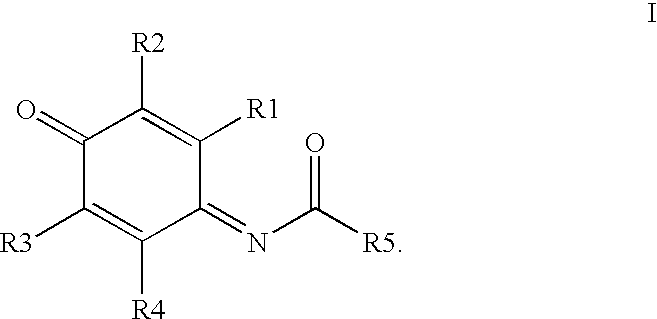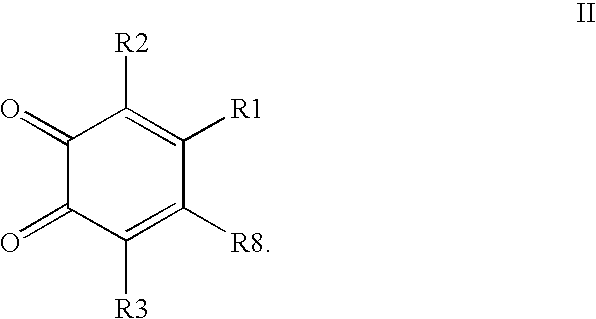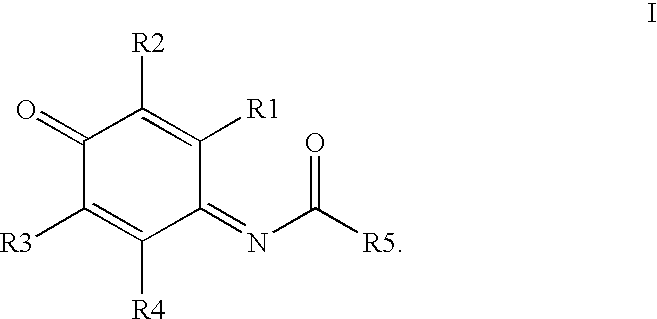Compounds having MIF antagonist activity
a technology applied in the field of compound and antagonist activity, can solve the problem of historical attribution of specific biological activities to single proteins now defined as mif, and achieve the effect of reducing the risk of bacterial infection
- Summary
- Abstract
- Description
- Claims
- Application Information
AI Technical Summary
Problems solved by technology
Method used
Image
Examples
example 1
Enzyme Inhibition Studies. This example illustrates the inhibition of the enzymatic activity of human MIF by iminoquinones. The enzymatic tautomerization activity of recombinant human MIF was performed using L-dopachrome methyl ester (1) as a chromogenic substrate (Bendrat et al., Biochemistry, 36:15356-15362, 1997). The tautomerization reaction catalyzed by MIF, as described in detail above, leads to the formation of a dihydroxyindole product (2), which is colorless (see FIG. 1A). N-Acetyl-p-benzoquinone imine (NAPQI; 4), which possesses the iminoquinone functionality of L-dopachrome methyl ester (1) acts as a potent electrophile, and has been shown to alkylate glutathione (Albano et al., Mol. Pharmacol., 28:306-311, 1985), and proteins such as papain (Chen et al., Biochemistry, 38:8159-8166, 1999), BSA (Streeter et al., Exp Med Biol., 197:727-737, 1986), and glutamate dehydrogenase (Halmes et al., Chem. Res. Toxicol. 9:541-546, 1996).
Compound 4 was tested to determine if it would ...
example 2
Quinone-Based Enzyme Inhibitors. This example shows the inhibitory activity of quinone-based (and iminoquinone-based) compounds against MIF enzymatic activity (summarized in Table I). The inhibitory activity of several related quinone-based compounds was tested against the enzymatic activity of MIF because compound 4, and related quinone-like agents, are known to react with nucleophiles, including thiols (Dahlin & Nelson, J. Med. Chem., 25:885-886, 1982; Rashed & Nelson. J. Chromatogr., 474:209-222, 1988; Fernando et al., J. Med. Chem., 23:1153-1158, 1980; Holme et al., Biochem. Pharmacol. 42:1137-1142, 1991; Chen et al., Chem. Res. Toxicol. 11:295-301, 1998; Albano et al., Mol. Pharmacol., 28:306-311, 1985; Chen et al., Biochemistry, 38:8159-8166, 1999; Streeter et al., Adv Exp Med Biol., 197:727-737, 1986; and Halmes et al., Chem. Res. Toxicol. 9:541-546, 1996). Of approximately 60 compounds tested, the most active contained ortho and para-quinoid structures related to that found ...
example 3
Covalent Enzyme Modification. This example shows that NAPQI (4) modifies MIF chemically to form a stable, covalent MIF-NAPQI conjugate (see FIG. 4). Compound 4 has previously been reported to react with protein nucleophiles and induce protein-protein crosslinking (Dahlin & Nelson, J. Med. Chem., 25:885-886, 1982; Chen et al., Chem. Res. Toxicol. 11:295-301, 1998). Analysis of reaction products by SDS-PAGE indicated that at concentrations of compound 4 that led to 94% MIF enzyme inhibition (190 .mu.M), there were small amounts of a 25 kDa species, consistent with the presence of crosslinked MIF monomers (see FIG. 4a and 4b, lanes 4). These results, and the fact that it was not possible to restore enzymatic activity by dialyzing or gel filtering MIF that was inactivated with compound 4 (data not shown), indicate the formation of a covalent adduct.
Covalent modification of MIF by compound 4 was confirmed by mass spectroscopy. MIF was chemically modified with compound 4 under conditions ...
PUM
| Property | Measurement | Unit |
|---|---|---|
| concentrations | aaaaa | aaaaa |
| concentration | aaaaa | aaaaa |
| molecular mass | aaaaa | aaaaa |
Abstract
Description
Claims
Application Information
 Login to View More
Login to View More - R&D
- Intellectual Property
- Life Sciences
- Materials
- Tech Scout
- Unparalleled Data Quality
- Higher Quality Content
- 60% Fewer Hallucinations
Browse by: Latest US Patents, China's latest patents, Technical Efficacy Thesaurus, Application Domain, Technology Topic, Popular Technical Reports.
© 2025 PatSnap. All rights reserved.Legal|Privacy policy|Modern Slavery Act Transparency Statement|Sitemap|About US| Contact US: help@patsnap.com



